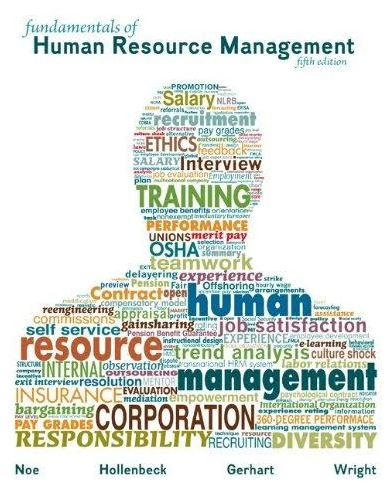
Fundamentals of Human Resource Management 5th Edition by Raymond Noe, John Hollenbeck, Barry Gerhart, Patrick Wright
Edition 5ISBN: 9780077515522
Fundamentals of Human Resource Management 5th Edition by Raymond Noe, John Hollenbeck, Barry Gerhart, Patrick Wright
Edition 5ISBN: 9780077515522 Exercise 9
A Revolving Door for Returning Vets
The president of a manufacturing company had the best of intentions. He was a retired military officer and wanted to provide jobs for some of the many service members ready to make a transition from military to civilian life. He expected that many of them had leadership qualities and would be an asset to his growing business. So he directed his company's human resources department to recruit veterans and track their progress.
A year and a half later, the company president reviewed the numbers and was shocked: many veterans were indeed being hired - and most of them were replacing veterans previously hired. The sad fact was that within months, most of them felt uncomfortable at the company and quit.
Research into this pattern has found a culture clash. Many employers find that their new employees don't know how to function in a civilian environment. What promoted success in the military is not always what works in civilian workplaces.
One solution is to develop orientation programs geared toward veterans. These new employees tend to face particular issues. For example, military organizations tend to emphasize standard processes. In contrast, many businesses want to foster creative thinking, which veterans might interpret as a lack of leadership or failure to communicate. Values such as loyalty and respect are highly prized in the military; veteran employees may be troubled if they perceive a lax attitude toward values in a civilian workplace. Thus, orientation might need to cover aspects of organizational culture that seem obvious to the civilian trainer. The orientation program might be best supplemented with a mentor who has a military background.
The effort to recruit and train veterans can be worthwhile for many reasons. Many employers prize veterans' strong values, leadership experience, and resourcefulness. The federal government offers guidance and assistance in recruiting and hiring veterans. The wind-down of the wars in Iraq and Afghanistan is creating a huge pool of talented, motivated individuals. And, of course, many employers want to do the right thing for persons who have sacrificed so much for the nation.
In the manufacturing company described here, the president himself was a veteran. Why do you think the newly hired veterans didn't feel at home in a company run by a veteran? What lessons does this suggest about how to plan an orientation program's content?
The president of a manufacturing company had the best of intentions. He was a retired military officer and wanted to provide jobs for some of the many service members ready to make a transition from military to civilian life. He expected that many of them had leadership qualities and would be an asset to his growing business. So he directed his company's human resources department to recruit veterans and track their progress.
A year and a half later, the company president reviewed the numbers and was shocked: many veterans were indeed being hired - and most of them were replacing veterans previously hired. The sad fact was that within months, most of them felt uncomfortable at the company and quit.
Research into this pattern has found a culture clash. Many employers find that their new employees don't know how to function in a civilian environment. What promoted success in the military is not always what works in civilian workplaces.
One solution is to develop orientation programs geared toward veterans. These new employees tend to face particular issues. For example, military organizations tend to emphasize standard processes. In contrast, many businesses want to foster creative thinking, which veterans might interpret as a lack of leadership or failure to communicate. Values such as loyalty and respect are highly prized in the military; veteran employees may be troubled if they perceive a lax attitude toward values in a civilian workplace. Thus, orientation might need to cover aspects of organizational culture that seem obvious to the civilian trainer. The orientation program might be best supplemented with a mentor who has a military background.
The effort to recruit and train veterans can be worthwhile for many reasons. Many employers prize veterans' strong values, leadership experience, and resourcefulness. The federal government offers guidance and assistance in recruiting and hiring veterans. The wind-down of the wars in Iraq and Afghanistan is creating a huge pool of talented, motivated individuals. And, of course, many employers want to do the right thing for persons who have sacrificed so much for the nation.
In the manufacturing company described here, the president himself was a veteran. Why do you think the newly hired veterans didn't feel at home in a company run by a veteran? What lessons does this suggest about how to plan an orientation program's content?
Explanation
In a case like this, it is not very obvi...
Fundamentals of Human Resource Management 5th Edition by Raymond Noe, John Hollenbeck, Barry Gerhart, Patrick Wright
Why don’t you like this exercise?
Other Minimum 8 character and maximum 255 character
Character 255


